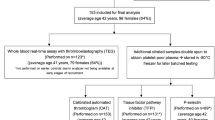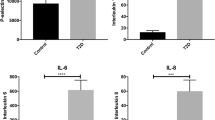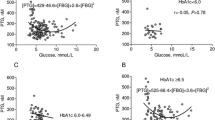Abstract
Diabetes is a risk factor for the development of atherothrombosis and venous thromboembolism (VTE). We investigated whether plasma from patients with type 2 diabetes has an imbalance of pro- versus anti-coagulation resulting in hypercoagulability despite normal conventional coagulation tests. We analyzed blood samples from 60 patients with type 2 diabetes and 60 gender- and age-matched healthy subjects (controls) for the levels of pro- and anti-coagulant factors, for thrombin generation and for the numbers of cell-derived circulating microparticles bearing such pro-coagulant triggers as tissue factor and negatively charged phospholipids. The levels of pro- or anti-coagulants as measured with conventional coagulation tests or single factor measurements were similar to those of the control population. In contrast, the median (range) of the height of the thrombin peak (taken as an index of thrombin generation) was higher in patients [205 nM (126–352)] than controls [151 nM (41−289)], P < 0.001. The median numbers of circulating microparticles were higher for patients [5,041/μl (1,821–13,132)] than for controls [1,753/μl (554–13,308)], P < 0.001 and their values were correlated with the height of the thrombin peak (ρ = 0.66, P < 0.001). In conclusion, plasma from patients with type 2 diabetes possesses an imbalance of pro- versus anti-coagulation resulting in hypercoagulability that can be detected by thrombin generation tests, but not by the measurement of the single pro- or anti-coagulant factors. This hypercoagulability is associated with increased numbers of circulating microparticles bearing endogenous pro-coagulant triggers. These findings might explain the relatively high risk of atherothrombosis and VTE described in these patients.


Similar content being viewed by others
References
Adeghate E, Schattner P, Dunn E (2006) An update on the etiology and epidemiology of diabetes mellitus. Ann N Y Acad Sci 1084:1–29
Coccheri S (2007) Approaches to prevention of cardiovascular complications and events in diabetes mellitus. Drugs 67:997–1026
Petrauskiene V, Falk M, Waernbaum I, Norberg M, Eriksson JW (2005) The risk of venous thromboembolism is markedly elevated in patients with diabetes. Diabetologia 48:1017–1021
Keenan CR, Murin S, White RH (2007) High risk for venous thromboembolism in diabetics with hyperosmolar state: comparison with other acute medical illnesses. Thromb Haemost 5:1185–1190
Stein PD, Goldman J, Matta F, Yaekoub AY (2009) Diabetes mellitus and risk of venous thromboembolism. Am J Med Sci 337:259–264
Heit JA, Leibson CL, Ashrani AA, Petterson TM, Bailey KR, Melton LJ III (2009) Is diabetes mellitus an independent risk factor for venous thromboembolism? a population-based case-control study. Arterioscler Thromb Vasc Biol 29:1399–1405
Ceriello A (1997) Fibrinogen and diabetes mellitus: is it time for intervention trials? Diabetologia 40:731–734
Sommeijer DW, Hansen HR, van Oerle R, Hamulyak K, van Zanten AP, Meesters E, Spronk HM, ten Cate H (2006) Soluble tissue factor is a candidate marker for progression of microvascular disease in patients with type 2 diabetes. J Thromb Haemost 4:574–580
Sauls DL, Banini AE, Boyd LC, Hoffman M (2007) Elevated prothrombin level and shortened clotting times in subjects with type 2 diabetes. J Thromb Haemost 5:638–639
Ceriello A, Quatraro A, Dello Russo P, Marchi E, Barbanti M, Milani MR, Giugliano D (1990) Protein C deficiency in insulin-dependent diabetes: a hyperglycemia-related phenomenon. Thromb Haemost 64:104–107
Ceriello A, Quatraro A, Marchi E, Barbanti M, Dello Russo P, Lefebvre P, Giugliano D (1990) The role of hyperglycaemia-induced alterations of antithrombin III and factor X activation in the thrombin hyperactivity of diabetes mellitus. Diabet Med 7:343–348
Hemker HC, Giesen P, Al Dieri R, Regnault V, de Smedt E, Wagenvoord R, Lecompte T, Béguin S (2003) Calibrated automated thrombin generation measurement in clotting plasma. Pathophysiol Haemost Thromb 33:4–15
Chantarangkul V, Clerici M, Bressi A, Giesen PL, Tripodi A (2003) Thrombin generation assessed as endogenous thrombin potential (ETP) in patients with hypo- or hyper-coagulability. Effects of phospholipids, tissue factor and residual platelets on the measurement performed in platelet-poor and platelet-rich plasma. Haematologica 88:547–554
Shet AS, Aras O, Gupta K, Hass MJ, Rausch DJ, Saba N, Koopmeiners L, Key NS, Hebbel RP (2003) Sickle blood contains tissue factor-positive microparticles derived from endothelial cells and monocytes. Blood 102:2678–2683
Prandoni P (2007) Links between arterial and venous disease. J Intern Med 262:341–350
Ageno V, Becattini C, Brighton T, Selby R, Kamphuisen PW (2008) Cardiovascular risk factors and venous thromboembolism. A meta-analysis. Circulation 117:93–102
Tripodi A, Chantarangkul V, Mannucci PM (2009) Acquired coagulation disorders: revisited using global coagulation/anticoagulation testing. Br J Haematol 147:77–82
van Hylckama Vlieg A, Christiansen SC, Luddington R, Cannegieter SC, Rosendaal FR, Baglin TP (2007) Elevated endogenous thrombin potential is associated with an increased risk of a first deep venous thrombosis but not with the risk of recurrence. Br J Haematol 138:769–774
Hron G, Kollars M, Binder BR, Eichinger S, Kyrle PA (2006) Identification of patients at low risk for recurrent venous thromboembolism by measuring thrombin generation. JAMA 296:397–402
Tripodi A, Legnani C, Chantarangkul V, Cosmi B, Palareti G, Mannucci PM (2008) High thrombin generation measured in the presence of thrombomodulin is associated with an increased risk of recurrent venous thromboembolism. J Thromb Haemost 6:1327–1333
Besser M, Baglin C, Luddington R, van Hylckama Vlieg A, Baglin T (2008) High rate of unprovoked recurrent venous thrombosis is associated with high thrombin-generating potential in a prospective cohort study. J Thromb Haemost 6:1720–1725
Tripodi A, Mannucci PM (2007) Abnormalities of hemostasis in chronic liver disease. Reappraisal of their clinical significance and need for clinical and laboratory research. J Hepatol 46:727–733
Tripodi A, Ramenghi LA, Chantarangkul V, De Carli A, Clerici M, Groppo M, Mosca F, Mannucci PM (2008) Normal thrombin generation in neonates in spite of prolonged conventional coagulation tests. Haematologica 93:1256–1259
Tripodi A, Cappellini MD, Chantarangkul V, Padovan L, Fasulo MR, Marcon A, Mannucci PM (2009) Hypercoagulability in splenectomized thalassemic patients detected by whole-blood thromboelastometry, but not by thrombin generation in platelet-poor plasma. Haematologica 94:150–157
Dahlback B (2004) Progress in the understanding of the protein C anticoagulant pathway. Int J Hematol 79:109–116
Couturaud F, Duchemin J, Leroyer C, Delahousse B, Abgrall JF, Mottier D, Groupe D’etude De La Thrombose De Bretagne Occidentale (G.E.T.B.O) (2008) Thrombin generation in first-degree relatives of patients with venous thromboembolism who have factor V Leiden. A pilot study. Thromb Haemost 99:223–228
Tripodi A, Primignani M, Chantarangkul V, Dell’Era A, Clerici M, de Franchis R, Colombo M, Mannucci PM (2009) An imbalance of pro- vs anti-coagulation factors in plasma from patients with cirrhosis. Gastroenterology 137:2105–2111
Davizon P, López JA (2009) Microparticles and thrombotic disease. Curr Opin Hematol 16:334–341
Burnier L, Fontana P, Kwak BR, Angelillo-Scherrer A (2009) Cell-derived microparticles in haemostasis and vascular medicine. Thromb Haemost 101:439–451
Jy W, Horstman LL, Jimenez JJ, Ahn YS, Biró E, Nieuwland R, Sturk A, Dignat-George F, Sabatier F, Camoin-Jau L, Sampol J, Hugel B, Zobairi F, Freyssinet JM, Nomura S, Shet AS, Key NS, Hebbel RP (2004) Measuring circulating cell-derived microparticles. J Thromb Haemost 2:1842–1851
Nomura S (2009) Dynamic role of microparticles in type 2 diabetes mellitus. Curr Diabetes Rev 5:245–251
Diamant M, Nieuwland R, Pablo RF, Sturk A, Smit JWA, Radder JK (2002) Elevated numbers of tissue factor exposing microparticles correlate with components of the metabolic syndrome in uncomplicated type 2 diabetes mellitus. Circulation 106:2442–2447
Sinauridze EI, Kireev DA, Popenko NY, Pichugin AV, Panteleev MA, Krymskaya OV, Ataullakhanov FI (2007) Platelet microparticles have 50- to 100-fold higher specific procoagulant activity than activated platelets. Thromb Haemost 97:425–434
Franchini M, Mannucci PM (2009) A new era of anticoagulants. Eur J Intern Med 20:562–568
Author information
Authors and Affiliations
Corresponding author
Rights and permissions
About this article
Cite this article
Tripodi, A., Branchi, A., Chantarangkul, V. et al. Hypercoagulability in patients with type 2 diabetes mellitus detected by a thrombin generation assay. J Thromb Thrombolysis 31, 165–172 (2011). https://doi.org/10.1007/s11239-010-0506-0
Published:
Issue Date:
DOI: https://doi.org/10.1007/s11239-010-0506-0




